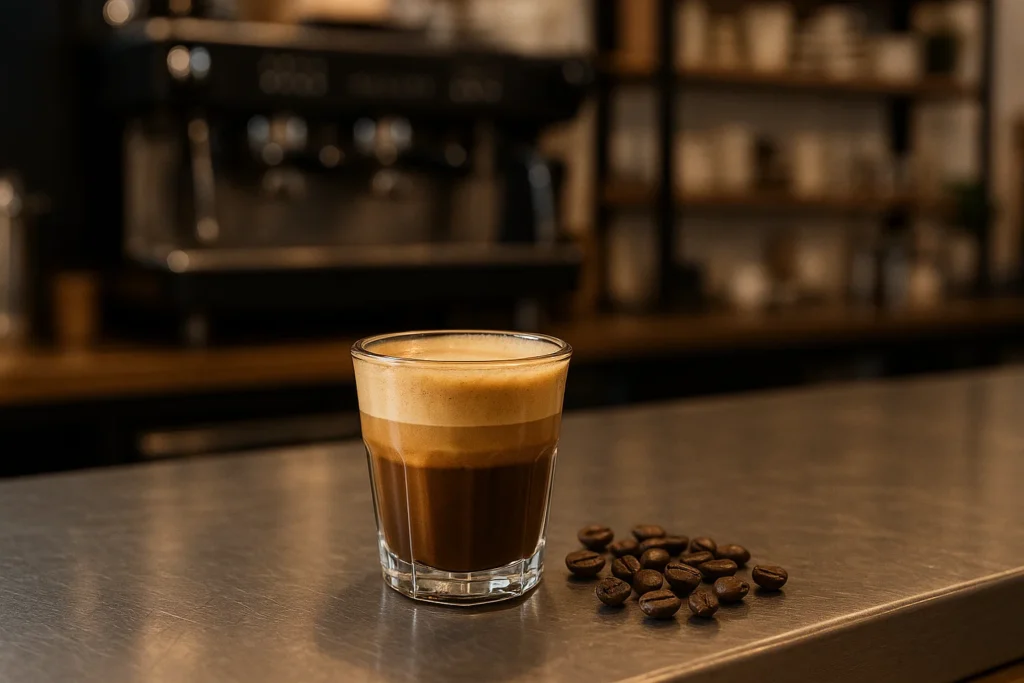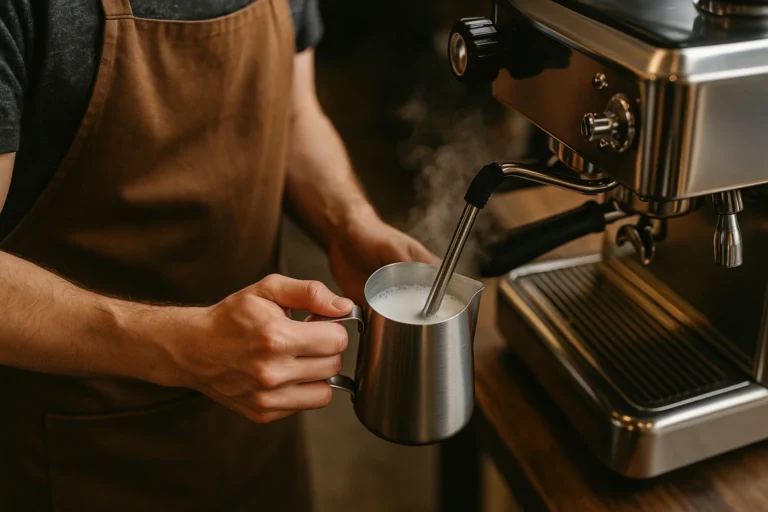Home » Coffee Knowledge » coffee-recipes » Espresso Essentials » Cortado Recipe: A Smooth Balance of Espresso and Milk
There’s something special about a drink that doesn’t scream for attention but still holds its ground. The cortado is that kind of coffee. No foam art. No towering layers. Just a shot of espresso softened by warm milk. It’s understated, balanced, and quietly confident — like that friend who always shows up on time and never needs to be the center of attention.
This cortado recipe is all about finding that perfect middle ground — bold but not bitter, creamy but not overly rich. It’s made with a 1:1 ratio of espresso to milk and typically served in a small glass. While it started as a staple in Spanish coffee culture, it’s found its way into specialty cafés across the U.S. If you love espresso but want something a bit smoother for your mid-morning break or afternoon recharge, the cortado hits the sweet spot. And best of all? You don’t need fancy gear or a barista certification to make one at home.
At its core, the cortado is about simplicity — just two ingredients, thoughtfully combined. But that simplicity is what makes it so satisfying. There’s no room to hide behind syrups or foamy distractions; it’s all about the quality of your espresso and how gently the milk softens its edges. Whether you’re easing into espresso drinks for the first time or you’ve been pulling shots for years, the cortado is a drink worth mastering.

A cortado is a simple espresso-based drink made with equal parts espresso and steamed milk. The name comes from the Spanish word “cortar,” which means “to cut” — because the milk cuts the intensity of the espresso without drowning it.
It’s smaller than a latte, smoother than a straight espresso shot, and creamier than a macchiato. Basically, it’s a happy middle ground for people who want bold flavor without the bitterness.
2 oz (1 shot) of espresso
2 oz of steamed milk (whole milk is traditional, but feel free to experiment with oat, almond, or your go-to milk substitute)
That’s it — just two ingredients in a 1:1 ratio.
Absolutely! Oat milk is my go-to for a dairy-free version. It steams up beautifully and has a creamy texture close to whole milk. Almond and soy work too, but they can sometimes split if overheated.
Pro tip: Use barista-style versions of non-dairy milks—they’re formulated to froth better.
The cortado’s roots trace back to Spain, where it was created as a way to tone down espresso’s intensity without losing its bold flavor. The name “cortado” literally means “cut” in Spanish — a nod to the way warm milk “cuts” through the sharpness of the espresso. It became especially popular in cafés across Madrid and the Basque Country, where simplicity and balance are key to coffee culture.
As third-wave coffee shops gained popularity in the U.S., the cortado followed — often served in a small glass (like a Gibraltar tumbler) with just enough milk to round out the shot. While it’s not as flashy as a latte or as quick as a straight espresso, the cortado has quietly earned its place as a favorite among baristas and coffee purists alike.
Aim for silky, not frothy. You’re not going for latte foam here — you want a smooth, steamed texture with little to no foam. Think warm and velvety.
Use whole milk for best results. It adds body and balances the espresso beautifully. That said, oat milk is a great plant-based option if you want something with similar creaminess.
No steam wand? No problem. Heat your milk on the stove or in the microwave, then whisk or shake it in a jar until it looks smooth and glossy — skip the big bubbles.
Don’t overheat. Milk starts to lose sweetness if it gets too hot. Keep it around 130–150°F (54–65°C) for the best flavor and texture.
Small amounts matter. Since a cortado uses just 2 oz of milk, precision helps. If you usually free-pour milk for lattes, try measuring for consistency.
If you like a touch of sweetness in your coffee, you can absolutely make a cortado that’s smooth and sweet — without drowning out the espresso. Here are a few low-key ways to do it:
Add a drop of honey or maple syrup – These dissolve easily in warm milk and add a subtle, natural sweetness.
Try vanilla extract – Just ¼ teaspoon can round out the flavor and give it a soft, cozy vibe.
Sprinkle in cinnamon or nutmeg – Not technically sweeteners, but they add warmth and a dessert-like aroma.
Sweetened condensed milk – For a richer, more indulgent twist, swap regular milk for this and you’re on your way to a Spanish-style café bombón.
Expert Tip: The cortado is a delicate drink. A little goes a long way. Add your sweetener after the espresso but before the milk so it blends smoothly.

Strong, smooth, and velvety—the perfect balance between bold espresso and creamy milk.
Use an espresso machine or a moka pot. Pour into an espresso cup.

Steam or heat 2 oz of milk to 130–150°F using a steam wand or milk frother. until velvety (not foamy)

Slowly pour the milk over the espresso, starting higher and lowering your pitcher to finish with a gentle stream. You should end with a creamy texture and a thin layer of microfoam across the top.

A flat white is not a shooter. Enjoy and savor in a few sips.

The beauty of a cortado lies in its simplicity — but as any barista will tell you, the simple drinks are often the hardest to perfect. With just two ingredients, every detail matters. Here are a few quick tips to help you consistently nail that smooth, balanced flavor:
Use freshly ground beans – The fresher the grind, the better the flavor. Medium-dark roasts work especially well.
Dial in your espresso shot – Aim for a 1:2 ratio (about 18g in, 36g out) pulled over 25–30 seconds for ideal strength.
Heat milk gently – Scalded milk loses sweetness. Stick to around 140°F for a silky texture and balanced flavor.
Keep your ratio tight – A true cortado is a 1:1 drink. Too much milk and you’re drifting into latte territory.
Use a small glass – Serving it in a 4–5 oz glass keeps the proportions just right and makes it feel intentional.
Stick to these basics and you’ll have a cortado that’s clean, consistent, and worthy of any café menu — all from your own kitchen.

Welcome to Coffee Slang—I’m Nick Puffer, a former barista turned coffee enthusiast. What started behind the counter became a passion I now share with others. Join me as we explore the craft, culture, and lifestyle of coffee.
We care a lot about the experience you have with coffee. A lot of work has gone into getting great beans to your door.
Get Updates From Us When We Create New Ways To Explore Coffee!